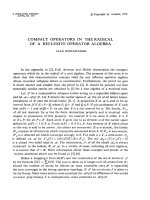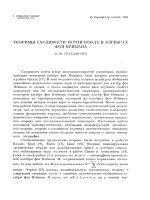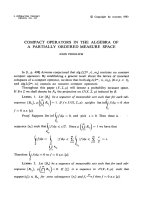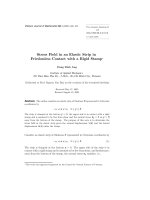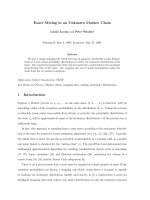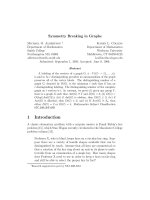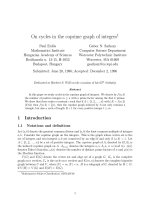Báo cáo toán hoc:" Rainbow matchings in r-partite r-graphs" pps
Bạn đang xem bản rút gọn của tài liệu. Xem và tải ngay bản đầy đủ của tài liệu tại đây (134.12 KB, 9 trang )
Rainbow matchings in r-partite r-graphs
Ron Aharoni
∗†
Department of Mathematics
Technion
Haifa
Israel 32000
Eli Berger
∗
Department of Mathematics
Faculty of Science and Science Education
Haifa University
Haifa, Israel
Submitted: Feb 24, 2009; Accepted: Sep 13, 2009; Published: Sep 25, 2009
Mathematics Subject Classification: 05D15
Abstract
Given a collection of matchings M = (M
1
, M
2
, . . . , M
q
) (repetitions allowed), a
matching M contained in
M is said to be s-rainbow for M if it contains repre-
sentatives from s m atchings M
i
(where each edge is allowed to represent just one
M
i
). Formally, this means that there is a function φ : M → [q] such that e ∈ M
φ(e)
for all e ∈ M, and |Im(φ)| s.
Let f (r, s, t) be the maximal k for which there exists a set of k matchings of size
t in some r-partite hypergraph, such that there is no s-rainbow matching of size t.
We prove that f (r, s, t) 2
r−1
(s − 1), make the conjecture that equality holds
for all values of r, s and t and prove the conjecture wh en r = 2 or s = t = 2.
In the case r = 3, a stronger conjecture is that in a 3-partite 3-graph if all vertex
degrees in one side (say V
1
) are strictly larger than all vertex degrees in the other
two sides, then there exists a matching of V
1
. This conjecture is at the same time
also a strengthening of a famous conjecture, described below, of Ryser, Brualdi and
Stein. We prove a weaker version, in which the d egrees in V
1
are at least twice as
large as the degrees in the other s ides . We also formulate a related conjecture on
edge colorin gs of 3-partite 3-graphs and prove a similarly weakened version.
1 Preliminaries
An r-graph (namely a hypergraph all of whose edges ar e of the same size r) is said to
be r-partite if the vertex set V (H) of H can be pa r t itio ned into sets V
1
, V
2
, . . . , V
r
in
such a way that every edge in H meets each V
i
at precisely one vertex. Generally, we
∗
The research was supported by BSF g rant no. 2006099.
†
The research of the first author was supported by GIF grant no. 2006311, by the Technion’s research
promotion fund, and by the Discont Bank chair.
the electronic journal of combinatorics 16 (2009), #R119 1
shall use the names V
1
, . . . , V
r
for the sides of an r-part ite hypergraph, without further
explicit mention. (There will be one exception, in which we shall enumerate the sides
V
0
, V
1
, . . . , V
r−1
.) A legal k-tuple (of vertices) is a set of vertices containing at most one
vertex from each V
i
.
Given a set X of vertices in a hypergraph H we write E(X) (or E
H
(X) if explicit
mention of the hypergraph H is necessary) for the multiset of partial edges {e \ X |
X ⊆ e ∈ H}. For an element x we write E(x) for E({x}) . We write d eg(X) for |E(X)|
(repetitions counted). Given a set U of vertices, we write ∆(U) for max{deg(u) | u ∈ U}
and δ(U) for min{deg(u) | u ∈ U}.
A matching in a hypergraph H is a subset of E(H) (the edge set of H) consisting
of disjoint edges. For the sake of brevity, we shall refer to a matching of size t as a
t-matching. The maximal size of a matching in a hypergraph H is denoted by ν( H).
Let M = (M
1
, M
2
, . . . , M
q
) be a collection of (possibly repeating) matchings, and let
M be a matching contained in
M. A function φ : M → [q] is called an earmarking
for M if φ(e) ∈ M
φ(e)
for all e ∈ M. The pair (M, φ) is then said to be an earmarked
matching. If |Im(φ)| s then the earmarked matching is said to be s-rainbow. If M has
an earmarking φ such that |Im(φ)| s we say also about M by itself that it is s-rainbow.
In this article we study matchings in r-partite r-graphs, and we are concerned with
the following question: what size q of a collection of t-matchings M = (M
1
, M
2
, . . . , M
q
)
in an r-partite r-graph guarantees the existence of an s-rainbow t-matching? (here t and
s are fixed parameters, s t).
Definition 1.1 Let r, s, t be numbers such that s t. We write f(r, s, t) for the maximal
size of a family of t-matching s in an r-partite r-unif orm hypergraph, possessing no s-
rainbow t-ma tchi ng.
Conjecture 1.2 f (r, s, t) = 2
r−1
(s − 1) for all r > 1 a nd for all s and t such that s t.
Note that the conjectured value of f is independent of t. One direction of the conjecture
can be somewhat strengthened:
Conjecture 1.3 Let m = 2
r−1
(s − 1). Given matchings M
1
, . . . , M
m+1
in an r -partite
r-graph, wh ere M
i
is a t-ma tching for all i m and M
m+1
consists of one edge, there
exists an s-rainbow t-matching.
2 Motivation
Like o thers who have studied rainbow matchings (see, e.g., [15, 16]) we are motivated by
famous conjectures of Ryser [13], Brualdi [5] and Stein [14]. To formulate t hem, we need
the following definitions.
A matrix is called a Latin rectangle if no two symbols in the same row or in the same
column are equal (here and below the “symbols” are the elements appearing in the cells
the electronic journal of combinatorics 16 (2009), #R119 2
of the matrix). A partial transversal (or plainly transversal) in a Latin m × n rectangle
is a set of entries, each in a different row and in a different column, and each contain-
ing a different symbol. The partial transversal is called a full trans versal if it is of size
min(m, n).
Conjecture 2.1 (Ryser-Brualdi-Stein) In an n ×n La tin square there exists a partial
transversal of size n − 1. If n is odd, then there exis ts a transversal of size n.
(Ryser conjectured the odd case, and Brua ldi and Stein independently conjectured
the case of general n.) In [9] it was shown that an n × n La t in square contains a partial
transversal of size n − O(log
2
n).
Forming a 3-partite 3-graph whose sides are the rows, columns and symbols, respec-
tively, and assigning to each entry in the Latin square an edge joining the appropriate
row, column and symbol, the conjecture can be restated as:
Conjecture 2.2 If in an n × n × n 3-partite 3-gra ph H every legal pair of vertices has
degree 1 then ν(H) n − 1.
Here is a mo re general conjecture, which possibly better captures the essence of the
matter:
Conjecture 2.3 If in a 3- partite 3-graph E(x) is a matching of siz e |V
1
| for every x ∈ V
1
then ν |V
1
| − 1.
And even stronger -
Conjecture 2.4 If in a 3-partite 3-graph E(x) is a matching of siz e |V
1
| + 1 for every
x ∈ V
1
then V
1
is matchable.
Note that the condition “V
1
is matchable” can also b e formulated as “the match-
ings E(x), x ∈ V
1
, have a |V
1
|-rainbow |V
1
|-matching”. This is the connection to the
topic of the present paper. In this terminology, the conjecture says that any collection
(M
1
, M
2
, . . . , M
n
) of (n + 1)-matchings in a bipartite graph has an n-rainb ow n-matching.
In fact, we believe that something stronger than Conjecture 2.4 is true:
Conjecture 2.5 If in a 3-partite 3-graph H with sides V
1
, V
2
, V
3
we have δ(V
1
) > ∆(V
2
∪
V
3
) then ν(H) = |V
1
|.
There is a sharp jump here. If δ (V
1
) = ∆(V
2
∪ V
3
) then it is possible that ν(H) =
|V
1
|
2
,
as shown by any disjoint union of copies of the 4-edges hypergraph (a
1
, b
1
, c
1
), (a
1
, b
2
, c
2
),
(a
2
, b
1
, c
2
), (a
2
, b
2
, c
1
).
We can prove “half” of this conjecture:
Theorem 2.6 If δ(V
1
) 2∆(V
2
∪ V
3
) then ν(H) = |V
1
|. Moreover, for every edge there
exists a matching o f V
1
containing e.
the electronic journal of combinatorics 16 (2009), #R119 3
The proof will use the following:
Theorem 2.7 [2] If for every subset U of V
1
there holds ν(E
H
(U)) > 2(|U| − 1) then
there exists a matching of V
1
.
Proof (of Theorem 2.6) Let e be an arbitrary edge. Let H
′
be the hypergraph obtained
from H by deleting from V (H) the V
1
-vertex of e, and deleting all edges meeting e. We
have to show that in H
′
there exists a matching of the first side, V
′
1
:= V
1
\ e. We shall
show that H
′
satisfies the conditions of Theorem 2.7. Wr ite D = ∆(V
2
∪ V
3
). Let U ⊆ V
′
1
.
Then |E
H
(U)| 2D| U |, and since e ∩ (V
2
∪ V
3
) meets at most 2(D − 1) edges apart from
e itself, it follows that
|E
H
′
(U)| 2D| U | − 2(D − 1) > 2D(|U| − 1) (1)
(Edges may be counted with multiplicity). By K¨onig’s edge coloring theorem, which states
that the edge chromatic number of a bipartite graph is equal to the maximal degree of the
graph, E
H
′
(U) can be partitioned into D matchings, and by (1) one o f these matchings
must be of size larger than 2(|U| − 1), proving the desired condition.
By a simple trick of duplicating all vertices in V
2
∪ V
3
and duplicating the V
2
∪ V
3
part
of each edge we can deduce another “half” version of the conjecture:
Corollary 2.8 If δ(V
1
) ∆(V
2
∪ V
3
) then ν(H)
|V
1
|
2
.
The same trick would give the following corollary of Conjecture 2.5, if indeed this
conjecture is true:
Conjecture 2.9 For k an integer, if δ(V
1
) >
1
k
∆(V
2
∪ V
3
) then ν(H)
|V
1
|
k
.
3 The lower bound in Conjectu r e 1.2
In this section we prove:
Theorem 3.1 f(r, s, t) 2
r−1
(s − 1).
Proof It is convenient in this setting to denote the sides of the r-graph under considera-
tion by V
0
, . . . , V
r−1
. For each function p : [r − 1] → {0, 1} define a matching M(p) of size
t, whose i-th edge (1 i t) is (u
i
0
, u
i
1
, . . . , u
i
r−1
), where u
i
j
= i +
kj
p(k) mod t. Let
M consist of s − 1 copies of each matching M(p), p ∈ {0, 1}
[r−1]
. Let M be a matching
of size t contained in the union of the matchings M(p). Clearly, M is perfect, namely
it covers all vertices of the hyperg r aph. We claim that it is equal to some M(p). To
prove this, let e = (1, u
1
, . . . , u
r−1
) be the edge in M whose first coordinate is 1, and let
f = ( 2 , v
1
, . . . , v
r−1
) be the edge whose first coordinate is 2. Suppose that e belongs to a
copy of M(p) and f belongs to a copy of M(q). Assume, for contradiction, that p = q,
the electronic journal of combinatorics 16 (2009), #R119 4
and let j be the first index such that p(j) = q(j). Then since u
j
= v
j
we have q(j) p(j),
and thus q(j) > p(j). But then the vert ex u
j
+1 in the j-th side of the hypergraph cannot
belong to any edge in M, contradicting the fact that M is perfect.
Continuing this way we see that all edges in M belong to the same M(p). Since t here
are only s − 1 copies of M(p) in M, this means that M is not s-rainb ow.
In this example there are lots of repeated edges in the matchings. With some trepi-
dation we conjecture the following:
Conjecture 3.2 Any set o f 2
r−2
(s − 1) + 2 matchings of size t, no two of which sharing
an edge, h as an s-colored t-matching contained in its union.
In the case r = 2 the conjecture is that a set of t+1 disjoint t-matchings has a t-rainbow
matching. This is yet another generalization of the Ryser-Brualdi-Stein conjecture.
4 The case r = 2
Theorem 4.1 f(2, s, t) = 2(s − 1).
Remark 4.2 Drisko [6] essentially prov ed f(2, t, t) = 2(t −1), where “essentially” means
that he considered onl y the case in which one side of the bipartite graph is of size t.
Proof For greater transparency of the proof, we first exhibit the main idea in the sp ecial
case s = t. Namely, we first prove Drisko’s result, that f(2, t, t) = 2(t − 1). Since by
Theorem 3.1 f(2, t, t) 2(t −1) we only have to show that f(2, t, t) 2(t− 1). The pro of
is shorter than that in [6].
Let M
1
, M
2
, . . . , M
2t−1
be a family of t-matchings in a bipartite graph with sides A
and B. Let K be a k-rainbow k-matching of maximal size k. We need to show that k t.
Assume for contradiction that k < t, and suppose w.l.o.g that the edges of K are taken
from the matchings M
2t−k
, M
2t−k+1
, . . . , M
2t−1
.
Write X
1
= A ∩ supp(K) (here and below the support, supp(M) of a matching M
is its union), so |X
1
| = |K| = k < t. Since |M
1
| = t > |X
1
|, there exists so me edge
e
1
= {a
1
, b
1
} ∈ M
1
disjoint from X
1
. If e
1
is disjoint from supp(K), then adding it to
K results in a (k + 1)-ra inbow (k + 1)-matching, contrary to the maximality assumption
on k. Thus we may assume that e
1
is incident with an edge f
1
= {b
1
, c
1
} ∈ K. Write
X
2
= (X
1
∪ {b
1
}) \ {c
1
}. Then |X
2
| = |X
1
| = k.
Since |M
2
| = t > k , there exists an edge e
2
= {a
2
, b
2
} ∈ M
2
disjoint from X
2
(possibly
with a
2
= a
1
or a
2
= c
1
). If b
2
∈ supp(K), then there exists an alternating path, whose
application to K (and earmarking the edges e
i
appearing in it by color i) results in a
(k + 1)-rainbow (k + 1)-matching. Thus we may assume that e
2
is incident with an edge
f
2
= {b
2
, c
2
} ∈ K. Write now X
3
= (X
2
∪ {b
2
}) \ {c
2
}.
Continuing this way k steps, all edges of K must a ppear as f
i
, and thus in the k + 1
st
step the edge e
k+1
does not meet X
k+1
= supp(K) ∩ B. This yields an alternating path
resulting in a (k + 1)-rainbow (k + 1)-matching, contradicting the maximality of k.
the electronic journal of combinatorics 16 (2009), #R119 5
The proof of the general case, s t, is similar, with one main difference: instead of
leaving each matching M
i
after o ne edge, we continue choosing edges from it, until all
edges in some matching M
j
represented in K have appeared as f
ℓ
’s.
To make this idea precise, let
ˆ
K be a k-rainbow t-matching, with maximal possible
value of k. Let φ be the appropriate earmarking function. Assuming that k < s, there
are at least s matchings M
i
not represented in it, so assume that M
1
, . . . , M
s
∈ Im(φ).
Let K =
ˆ
K \ {e}, where e is an edge which is not the only one of its color. Now start
a process similar to that in the above proo f, starting with M
1
. But after having chosen
e
1
= {a
1
, b
1
} ∈ M
1
disjoint from X
1
= A ∩ supp(K), and letting f
1
= {b
1
, c
1
} be the edge
in K meeting e
1
, we do not necessarily switch to M
2
. Unless f
1
is the only one of its
color in (K , φ ↾ K), we continue with M
1
. Namely, we choose an edge e
2
= {a
2
, b
2
} ∈ M
1
Disjoint from X
2
= (X
1
∪{b
1
})\{c
1
}. If b
2
∈ supp(K) then applying the alternating path
ending at b
2
gives a (k + 1)-rainbow t-matching, contradicting the maximality of k. Note
that we use here the assumption that f
1
is not the only one in its color when claiming
that the obtained matching is (k + 1)-rainbow.
Thus we can assume that e
2
meets at B some edge f
2
= {b
2
, c
2
} ∈ K. We continue
this way, until the first time in which the set F
i
= {f
1
, . . . , f
i
} satisfies F
i
⊇ φ
−1
(j
1
) for
some j
1
. When this happens, say at an index i = i
1
, we switch to M
2
, namely we find
an edge e
i
1
+1
= {a
i
1
+1
, b
i
1
+1
} ∈ M
2
disjoint from X
i
1
+1
. Assuming, for contradiction,
that b
i
1
+1
∈ supp(K) , the matching obtained from K by applying the alternating path
ending at b
i
1
+1
is a (k + 1)-rainbow t-matching. Thus we may assume that e
i
1
+1
meets
some edge f
i
1
+1
∈ K. We now continue with M
2
, until for some index i
2
= i
1
the set
F
i
2
= {f
1
, . . . , f
i
2
} satisfies F
i
2
⊇ φ
−1
(j
2
) for some j
2
. We then switch to M
3
, and so on.
After k such switches all colors j represented in (K, φ) are exhausted, which means
that at the k + 1
st
stage the edge e
i
k
+1
does not meet X
i
k
+1
= B ∩supp(K), which results
in a (k + 1)-rainbow t-matching.
5 The case s = t = 2
Theorem 5.1 f(r, 2 , 2) = 2
r−1
for all r.
Proof Let M
i
, i q be a set of 2-matchings in an r-partite hypergraph, having no 2-
rainbow matching. For each i write M
i
= {e
i
, f
i
}. Let A
i
= e
i
for 1 i q, A
i
= f
i−q
for q + 1 i 2q, and B
i
= f
i
for 1 i q, B
i
= e
i−q
for q + 1 i 2q. Then
A
i
∩ B
i
= ∅, while the assumption that there is no 2-rainbow matching implies that
A
i
∩ B
j
= ∅ for all i = j. In [4] an upper bound was proved o n the size of such a general
system (A
i
, B
i
) satisfying this condition. Alon [3], using a multilinear algebraic proof
of Bollob´as’ theorem discovered by Lov´asz, proved that if the ground set is partitioned
into sets V
m
such that |A
i
∩ V
m
| = r
m
and |B
i
∩ V
m
| = s
m
for all i and m, then the
number of pairs is at most
i
r
i
+s
i
r
i
. In our case, taking the sets V
m
to be the sides of
the hypergraph, we have r
m
= s
m
= 1, implying that the number o f pairs, namely 2q,
does not exceed 2
r
. Thus q 2
r−1
.
the electronic journal of combinatorics 16 (2009), #R119 6
Here is a somewhat shorter proof, due to Roy Meshulam [12]. For each edge g =
(a
1
, a
2
, . . . , a
r
) participating in a matching M
i
define a polynomial P
g
=
(x
i
− z(a
i
)),
where z(a
i
) are numbers that are chosen to be algebraically independent. Then every
edge g ∈
M
i
has a substitution x
g
of values for the variables x
j
, such that P
g
(x
g
) = 0
while P
h
(x
g
) = 0 for all edg es h ∈
M
i
\ {g}. To see this, simply take the other edge,
say (b
1
, b
2
, . . . , b
r
) in the matching M
i
containing g, and let x
g
= (z(b
1
), z(b
2
), . . . , z(b
r
)).
Thus the polynomials P
g
are all independent, and hence their number does not exceed
the dimension of the space of multilinear po lynomials in x
1
, x
2
, . . . , x
r
, which is 2
r
. Thus,
again, 2q 2
r
, proving the desired conclusion.
Again, a slight adaptation of the proof yields also Conjecture 1.3 for s = t = 2.
6 Edge colorings in r-partit e hypergraphs
As in graphs, the edge chromatic number χ
e
(H) of a hypergraph H is defined to be the
minimal numb er of matchings whose union is the entire edge set of the hypergraph. In
[7] the f ollowing generalization of K¨onig’s edge coloring theorem was conjectured:
Conjecture 6.1 In an r-partite r-graph H w i th maximal vertex degree ∆ there holds:
χ
e
(H) (r − 1)∆.
We propose the following stronger:
Conjecture 6.2 In an r-partite r-graph H with sides V
1
, . . . , V
r
there holds: χ
e
(H)
max(∆(V
1
),
r
i=2
∆(V
i
)).
A special case is:
Conjecture 6.3 If in a 3-partite hypergraph H it is true that δ(V
1
) 2∆(V
2
∪ V
3
), then
χ
e
(H) = ∆(H).
This generalizes a conjecture of Hilton [11]:
Conjecture 6.4 The cells of any m × 2m Latin rectangle can be decomposed into 2m
transversals.
The derivation of Hilton’s conjecture is done by the transformation described in Section
2. In [8] an asymptotic version of Conjecture 6.4 was proved, namely that the cells o f any
m × (1 + ǫ)m Latin rectangle can be decomposed into (1 + ǫ)m t ransversals, for m large
enough (ǫ being any fixed positive number). Also, “half” of Conjecture 6.4 was proved
there: the cells of any m × 4m Latin rectangle can be decomposed into 4m transversals
for any m. It is interesting to note that while Hilton’s conjecture may be true for m + 1
replacing 2m, in Conjecture 6.3 the bound 2∆(V
2
∪ V
3
) on ∆(V
1
) is sharp. The example
is obtained from the 4-edges hypergraph (a
1
, b
1
, c
1
), (a
1
, b
2
, c
2
), (a
2
, b
1
, c
2
), (a
2
, b
2
, c
1
) (the
example used for the sharpness of Conjecture 2.5), with edges multiplied
m
2
times, and
the electronic journal of combinatorics 16 (2009), #R119 7
dangling edges added in V
1
, so that the degrees in V
1
are 2m−1, and ∆(V
2
∪V
3
) = m. Since
the line graph of the hypergraph (whose vertices are the edges of the hypergraph, two of
them being joined if they intersect) contains a clique of size 2m, we have χ
e
(H) 2m,
namely the edge chroma t ic number is larger than the degrees in V
1
.
Here we shall prove “half” of Conjecture 6.3:
Theorem 6.5 If in a 3-partite hypergraph H it is true that δ(V
1
) 4∆(V
2
∪ V
3
), then
χ
e
(H) = ∆(H).
Proof The proof uses an idea taken from [10]. In fact, we shall use a simplified version,
used in [1], for which an appropriate name is the “beating boys” method. Write k =
∆(V
2
∪ V
3
) and t = ∆(H). let f be a maximum t-coloring of the edges, namely a partial
coloring that colors a maximal number of edges. Assuming the negation o f the theorem,
there exists an edge (x, y, z) not colored by f . For any vertex u denote by E(u ) the set
of edges containing u. Then there exists a color not appearing among the colors given by
f to edges in E(x). Without lo ss of generality, we may assume that this color is 1. For
every u ∈ V
1
, if t here exists in E(u) an edge e colored 1 by f , remove from E(u) all edges
b = (u, v, w) ∈ dom(f) (where dom(f), the domain of f, is the set of edges colored by f,)
for which there exists some edge h = (p, q, r) such that (a) p = u, (b)f(h) = f(b) and (c)
h meets e. (The edge b is a “beating boy” of h, deleted just because it carries the same
color as h.) Let E
′
be the set of edges remaining aft er all these deletions, and let H
′
be
the hypergraph whose edge set is E
′
.
Since |E(u)| 4k for every u ∈ V
1
, and since every edge e = (u, v, w) meets at most
2k edges of the form (p, q, r), where p = u, it follows that E
′
(u) 2k for every u ∈ V
1
.
By Theorem 2.6 it follows that there exists in H
′
a matching M of V
1
, containing the
edge (x, y, z). Color all edges in M by color 1, and for every edge a = (p, q, r) colored
1 by f, if there exists an edge b = (p, v, w) ∈ M (namely, an edge in M sharing with a
its V
1
-vertex), re-color a by the color f (b). This produces a coloring f
′
whose domain is
larger than that of f , since (x, y, z) is colored by it. A contradiction (to the assumption
that f is not total) will be shown if we prove that f
′
is a legal coloring. Assuming it is
not, there exist two intersecting edges b = (p, v
1
, w
1
) and c = (q, v
2
, w
2
) colored by the
same color, say i. This could occur only if one of them, say b, was colored 1 by f and
it was recolored i because an edge c ∈ M ∩ E(p) was colored i. But this is impossible,
because in such a case b would have been removed from E as the “beating boy” of c.
Acknowledgement We are indebted to Ran Ziv for a stimulating remark, and to Noga
Zewi for proving Corollary 2.8.
References
[1] R. Aharoni, E. Berger and R. Ziv, Indep endent systems of representatives in weighted
graphs, Combinatorica 27 (2007), 253–267
the electronic journal of combinatorics 16 (2009), #R119 8
[2] R. Aharoni and P. Haxell, Hall’s theorem for hypergraphs. J. Graph Theory 35
(2000), 83-88
[3] N. Alon, An extremal problem for sets with applications to graph theory, J. Combi-
natorial Theory, Ser. A 40(1 985), 82–89.
[4] B. Bolloba´as. On generalized graphs, Acta Math. Acad. Sci. Hung. 16(1965), 447–
452.
[5] R. A. Brualdi and H. J. Ryser, Combinatorial Matrix Theory, Cambridge University
Press, Cambridge, UK, 1 991.
[6] A.A. Drisko, Transversals in row-Latin rectangles, J. Combin. Theory Ser. A, 84
(1998), 181–195.
[7] Z. Furedi, J. Kahn, and P. D. Seymour, On the fractional matching polytope of a
hypergraph, Combinatorica 13(2), 167–180 (1993).
[8] R. Haggkvist and A. Johansson, Orthogonal latin rectangles, Combina torics, Proba-
bility and Computing 17(4) (2008), 5 19-536.
[9] P. Hatami and P. W. Shor, A lower bound for the length of a partial transversal in
a Latin square, J. Combin. Theory, S er. A 115 (2008 ) , 1103-11 13.
[10] P.E. Haxell, On the strong chromatic number, Combinatorics, Probability and Com-
puting 13 (2004), 857865.
[11] A. J. W. Hilton, Problem BCC 13.2 0. Discrete Math. 125 (1994), 407–417.
[12] R. Meshulam, private communication.
[13] H. J. Ryser, Neuere Problem in der Kombinatorik, in Vortraheuber Kombinatorik,
Oberwohlfach (1967), 69-91.
[14] S. K. Stein, Transversals of Latin Squares and their generalizations, Pacific J. Math.
59 (1975), 567-575.
[15] D. E. Woolbright, On the size of partial 1-factors of 1-factorizations of the complete
k- uniform hypergraph on kn vertices, Ars Combin 6 (1978), 185-192.
[16] D. E. Woolbright and H. L. Fu, On the existence of rainbows in 1-factorizations of
K
2n
, J. C ombin D esigns 6 (1998), 1-20 .
the electronic journal of combinatorics 16 (2009), #R119 9
